Economic Assessment of Herbicide Use in Rice Under Different Establishment Methods in Northwest India
Abstract
1. Introduction
2. Materials and Methods
3. Results
3.1. Weed Species Observed in the Fields
3.2. Herbicide Use Pattern
3.3. Economics of Weed Control
4. Discussion
5. Conclusions
Author Contributions
Funding
Institutional Review Board Statement
Informed Consent Statement
Data Availability Statement
Conflicts of Interest
Abbreviations
| PTR | Puddled transplanted rice |
| DSR-PSI | Direct seeded rice sown after pre-sowing irrigation |
| DSR-IAS | Direct seeded rice with irrigation after sowing |
| DAS | Days after sowing |
References
- Kaur, P.; Gill, J.S.; Kumar, P.; Singh, P. Popularization of Direct Seeded Rice for Sustainability in Sangrur District of Punjab. Indian J. Econ. Dev. 2018, 14, 434–436. [Google Scholar] [CrossRef]
- Hira, G.S. Water management in northern states and the food security of India. J. Crop Improv. 2009, 23, 136–157. [Google Scholar] [CrossRef]
- Reiner, W.; Aulakh, M.S. The role of rice plants in regulating mechanisms of methane emissions. Biol. Fertil. Soils 2000, 31, 20–29. [Google Scholar]
- Kumar, V.; Ladha, J.K. Direct seeding of rice: Recent developments and future research needs. Adv. Agron. 2011, 111, 297–413. [Google Scholar]
- Balasubramanian, V.; Hill, J.E. Direct seeding of rice in Asia: Emerging issues and strategic research needs for the 21st Century. In Proceedings of the Direct Seeding: Research Issues and Opportunities; Pandey, S., Mortimer, M., Wade, L., Tuong, T.P., Lopez, K., Hardy, B., Eds.; IRRI: Los Baños, Philippines, 2002; pp. 15–39. [Google Scholar]
- Ladha, J.K.; Rao, A.N.; Raman, A.K.; Padre, A.T.; Dobermann, A.; Gathala, M.; Kumar, V.; Saharawat, Y.; Sharma, S.; Piepho, H.P.; et al. Agronomic improvements can make future cereal systems in South Asia far more productive and result in a lower environmental footprint. Glob. Change Biol. 2016, 22, 1054–1074. [Google Scholar] [CrossRef]
- Chakraborty, D.; Ladha, J.K.; Rana, D.S.; Jat, M.L.; Gathala, M.K.; Yadav, S.; Rao, A.N.; Ramesha, M.S.; Raman, A. A global analysis of alternative tillage and crop establishment practices for economically and environmentally efficient rice production. Sci. Rep. 2017, 7, 9342. [Google Scholar] [CrossRef] [PubMed]
- Joshi, E.; Dinesh, K.; Lal, B.; Nepalia, V.; Gautam, P.; Vyas, A.K. Management of direct-seeded rice for enhanced resource use efficiency. Plant Knowl. J. 2013, 2, 119–134. [Google Scholar]
- Rao, A.N.; Nagamani, A. Available technologies and future research challenges for managing weeds in dry-seeded rice in India. In Proceedings of the 21st Asian-Pacific Weed Science Society (APWSS) Conference, Colombo, Sri Lanka, 2–6 October 2007; Marambe, B., Sangakkara, U.R., De Costa, W.A.J.M., Abeysekara, A.S.K., Eds.; University of Peradeniy: Galaha, Sri Lanka; Chemical Industries (Colombo) Ltd.: Colombo, Sri Lanka, 2007; pp. 392–401. [Google Scholar]
- Rao, A.N.; Johnson, J.E.; Sivaprasad, B.; Ladha, J.K.; Mortimer, A.M. Weed management in direct-seeded rice. Adv. Agron. 2007, 93, 153–255. [Google Scholar]
- Rao, A.N.; Ladha, J.K. Possible approaches for ecological weed management indirect-seeded rice in a changing world. In Proceedings of the 23rd Asian Pacific Weed Science Society (APWSS) Conference, Cairns, QLD, Australia, 26–29 September 2011; pp. 444–453. [Google Scholar]
- Shekhawat, K.; Rathore, S.S.; Chauhan, B.S. Weed management in dry direct-seeded rice: A review on challenges and opportunities for sustainable rice production. Agronomy 2020, 10, 1264. [Google Scholar] [CrossRef]
- Matloob, A.; Khaliq, A.; Chauhan, B.S. Chapter Five—Weeds of Direct-Seeded Rice in Asia: Problems and Opportunities. Adv. Agron. 2015, 130, 291–336. [Google Scholar]
- Bhullar, M.S.; Singh, S.; Kumar, S.; Gill, G. Agronomic and economic impacts of direct-seeded rice in Punjab. Agric. Res. J. 2018, 55, 236–242. [Google Scholar] [CrossRef]
- Kaur, K.; Kaur, P.; Kaur, T. Problems faced by farmers in cultivation of direct seeded rice in Indian Punjab. Agric. Res. J. 2017, 54, 428–431. [Google Scholar] [CrossRef]
- Kumar, S.; Shivani, M.; Mishra, J.S.; Kumar, S.; Kumar, U.; Bharati, R.C. Efficacy of pre- and post-emergence herbicides on complex weed flora in direct-seeded rice (Oryza sativa) in the eastern plains. Indian J. Agric. Sci. 2018, 88, 387–392. [Google Scholar] [CrossRef]
- Bamal, D.; Duhan, A.; Pal, A.; Beniwal, R.K.; Kumawat, P.; Dhanda, S.; Goyat, A.; Hooda, V.S.; Yadav, R. Herbicide risks to non-target species and the environment: A review. Environ. Chem. Lett. 2024, 22, 2977–3032. [Google Scholar] [CrossRef]
- Casado, J.; Brigden, K.; Santillo, D.; Johnston, P. Screening of pesticides and veterinary drugs in small streams in the European Union by liquid chromatography high resolution mass spectrometry. Sci. Total Environ. 2019, 670, 1204–1225. [Google Scholar] [CrossRef]
- Gill, J.; Bhullar, M.S. Tar-wattar DSR: A solution to labour problem. Progress. Farming 2020, 56, 5–6. [Google Scholar]
- Yaduraju, N.T.; Rao, A.N.; Bhullar, M.S.; Gill, J.S.; Malik, R.K. Direct-Seeded Rice (DSR) in India: New opportunities for Rice Production and Weed management in post-COVID-19 pandemic period. Weeds J. Asian-Pac. Weed Sci. Soc. 2021, 3, 30–48. [Google Scholar]
- Kumar, A.; Brar, N.S.; Pal, S.; Singh, P. Available soil macro and micro-nutrients under rice wheat cropping system in District Tarn Taran of Punjab. Ecol. Environ. Conserv. 2017, 23, 202–207. [Google Scholar]
- Sondhia, S. Herbicides residues in soil, water, plants and non-targeted organisms and human health implications: An Indian perspective. Indian J. Weed Sci. 2014, 46, 66–85. [Google Scholar]
- Choudhury, P.P.; Singh, R.; Ghosh, D.; Sharma, A.R. Herbicide Use in Indian Agriculture; ICAR—Directorate of Weed Research: Jabalpur, India, 2016; p. 110. [Google Scholar]
- APVMA. Public Release Summary on the Evaluation of the New Active Florpyrauxifen-Benzyl (Rinskor™) in the Product GF-3301 Herbicide; Australian Pesticides and Veterinary Medicines Authority: Canberra, Australia, 2018; p. 50. Available online: https://www.apvma.gov.au/sites/default/files/publication/29096-gf-3301_herbicide-prs.pdf (accessed on 11 March 2025).
- Kaur, S.; Ahmed, S.; Awan, T.H.; Ali, H.H.; Singh, R.; Mahajan, G.; Chauhan, B.S. Adoption Pattern of Direct-Seeded Rice Systems in Three South Asian Countries during COVID-19 and Thereafter. Crops 2024, 4, 324–332. [Google Scholar] [CrossRef]
- Yadav, D.B.; Yadav, A.; Gill, G. Direct seeded rice in north-western India: Shift in weed flora and its management. In Proceedings—25th Asian-Pacific Weed Science Society Conference on “Weed Science for Sustainable Agriculture, Environment and Biodiversity”; Indian Society of Weed Science, ICAR-Directorate of Weed Research: Jabalpur, India, 2015; p. 58. [Google Scholar]
- Khaliq, A.; Matloob, A.; Ahmad, N.; Rasul, F.; Awan, I.U. Post emergence chemical weed control in direct seeded fine rice. J Anim. Plant Sci. 2012, 22, 1101–1106. [Google Scholar]
- Arya, S.R.; Ameena, M. Efficacy of new generation herbicides for weed management in dry direct seeded system of rice. Ann. Agric. Res. 2017, 38, 149–154. [Google Scholar]
- Gianessi, L.P.; Silvers, C.S.; Sankula, S.; Carpenter, J.E. Plant Biotechnology: Current and potential Impact for Improving Pest Management in U.S. Agriculture. Analysis of 40 Case Studies; The National Center for Food and Agriculture Policy: Washington, DC, USA, 2002; p. 210. [Google Scholar]
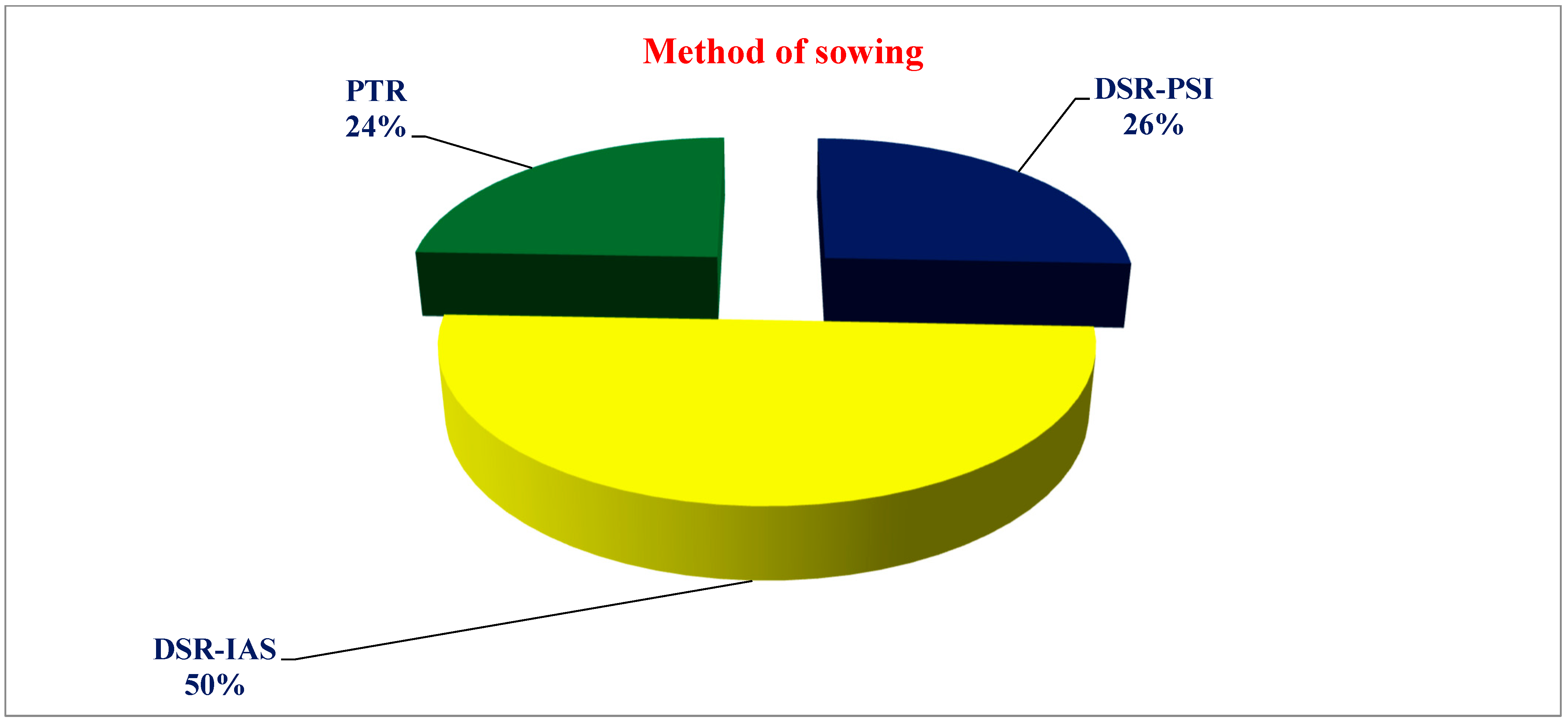
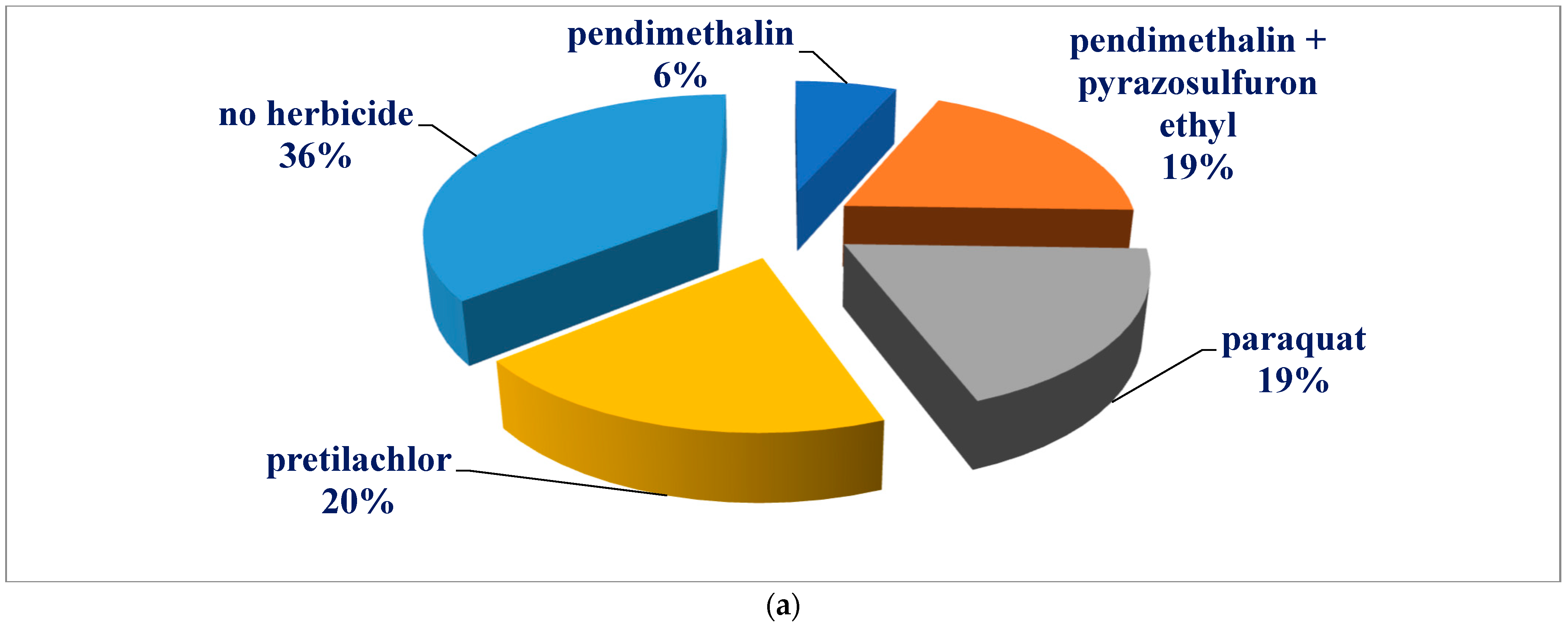
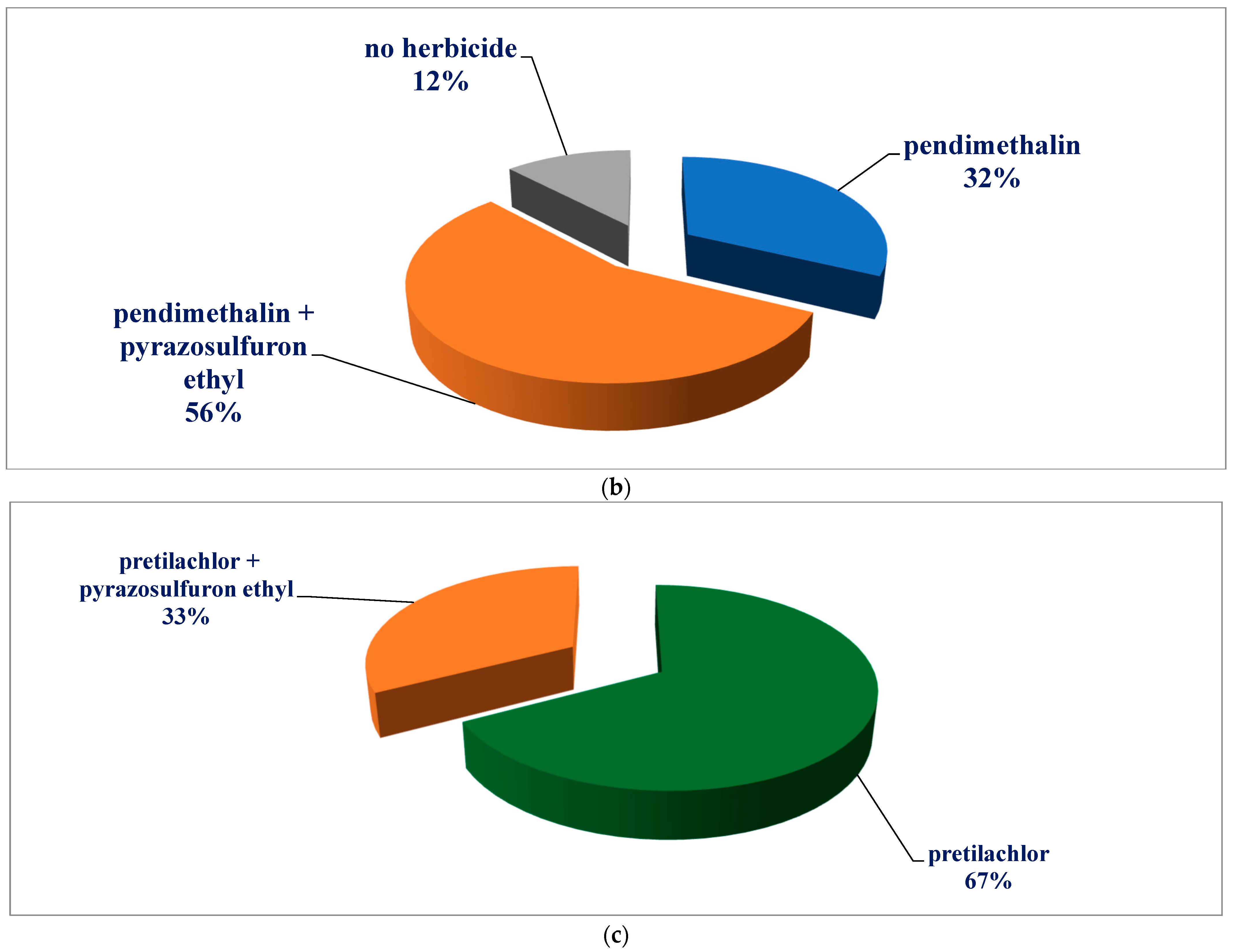
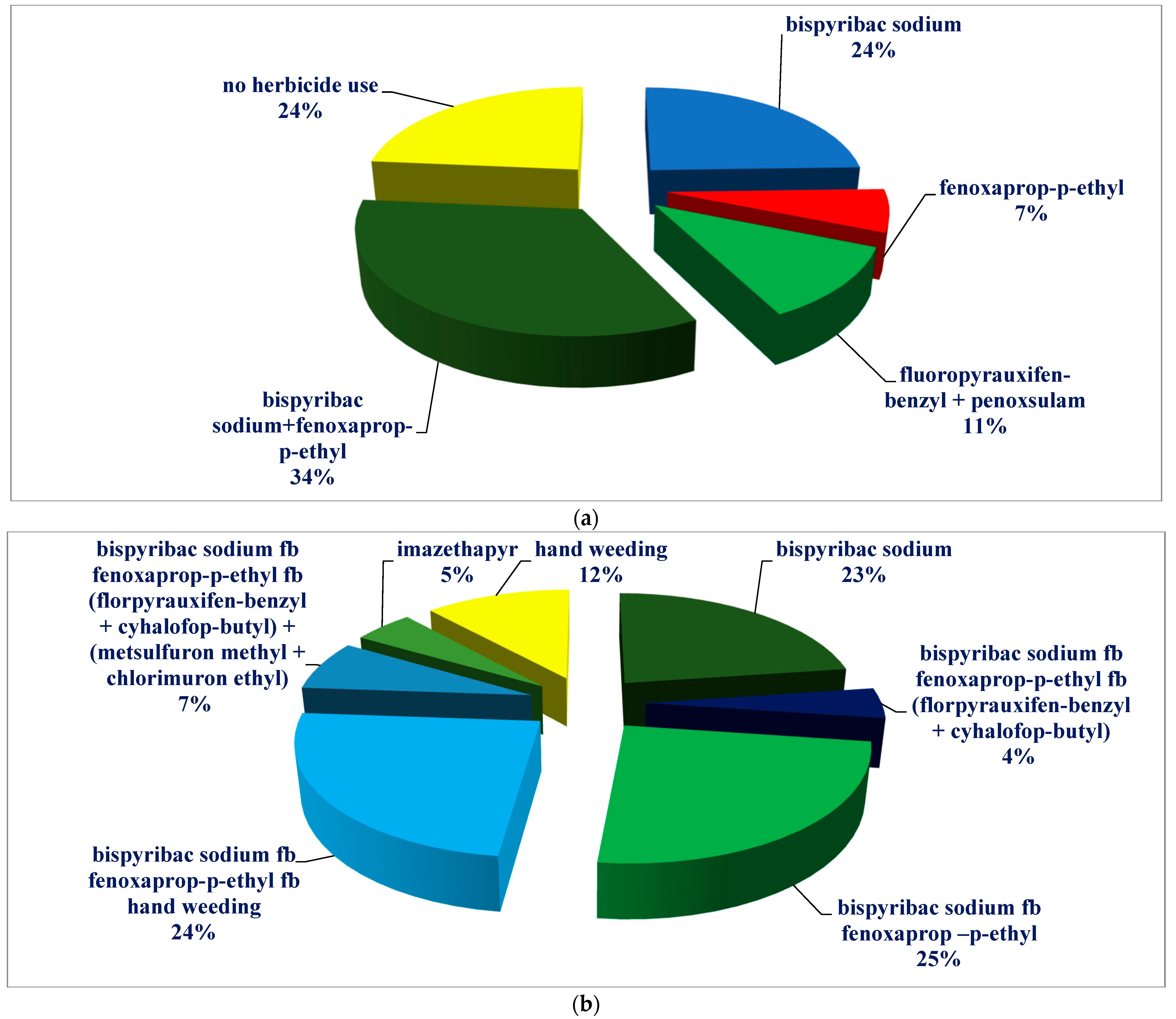
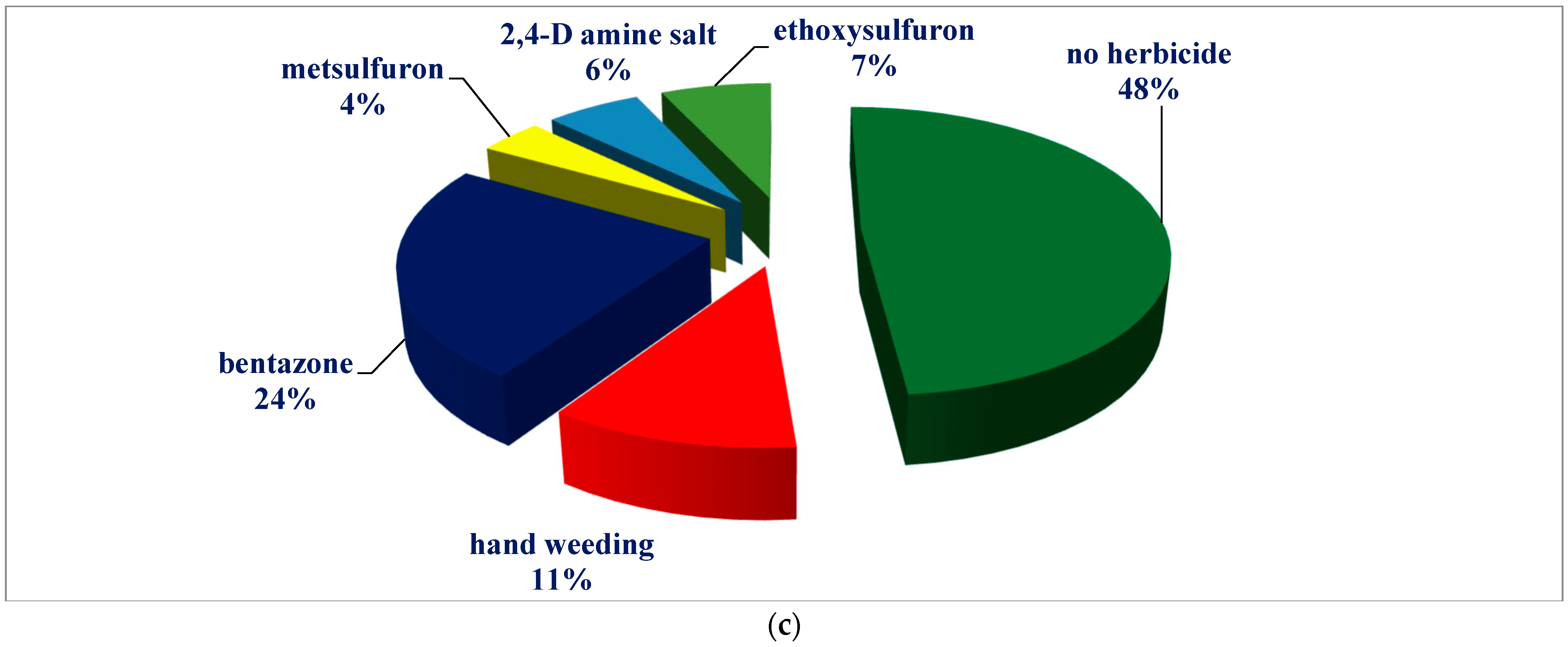
| S. No. | Input/Farm Operation | PTR | DSR-PSI | DSR-IAS |
|---|---|---|---|---|
| 1. | Seed rate (kg/ha) | 12.5 | 20 | 20 |
| 2. | Time of sowing/ Transplanting under PTR | 10 June 2024 to 25 June 2024 | 10 May 2024 to 5 June 2024 | 10 May 2024 to 5 June 2024 |
| 3. | First irrigation | Transplanted in puddled field with ponded water | 12 to 21 DAS | 1 to 2 DAS |
| 4. | Subsequent irrigations | Irrigation water kept ponded in field for first 20–30 days and afterwards irrigation was applied at 2–3 days interval | At 2–5 days interval | At 2–3 days interval |
| 5. | Method of application of pre emergence herbicide | Broadcasted in standing water after mixing with sand | Sprayed with knap sack sprayer fitted with flat fan/flood jet nozzle | Sprayed with knap sack sprayer fitted with flat fan/flood jet nozzle |
| 6. | Time of application of pre emergence herbicide | 2–5 DAT | 1–2 DAS | 4–5 DAS |
| 7. | Time of application of post emergence herbicide | 30–40 DAT | 30–50 DAS | 30–60 DAS |
| 8. | Dose of nitrogenous fertilizer (Urea; kg/ha) | 280 to 400 | 350 to 450 | 350 to 450 |
| 9. | Time of application of Urea | In three splits between 10–50 DAT | In three splits between 10–70 DAS | In three splits between 10–70 DAS |
| Method of Rice Establishment | Weed Flora | ||
|---|---|---|---|
| Grasses | Broadleaf | Sedges | |
| DSR-PSI/DSR-IAS | Echinochloa crus-galli | Ludwigia parviflora | Cyperus rotundus |
| Echinochloa colona | Trianthema monogyna | Cyperus iria | |
| Leptochloa chinensis | Eclipta alba | Scirpus roylei | |
| Dactyloctenium aegyptium | Digera arvensis | ||
| Eleusine indica | |||
| PTR | Echinochloa crus-galli | Ludwigia parviflora | Cyperus iria |
| Echinochloa colona | Hydrilla verticillata | Cyperus difformis | |
| Leptochloa chinensis | Eclipta alba | Scirpus roylei | |
| Name | Formulation | LD50, Acute, Oral, Rat (mg/kg) | LD50, Acute, Dermal, Rat (mg/kg) | Toxic Rating * |
|---|---|---|---|---|
| Bispyribac-sodium | 10% SC | 4111 | >2250 | IV |
| Chlorimuron ethyl | 25% WP | >4102 | >2000 | IV |
| Cyhalofop-butyl | 10% SC | >5000 | >2000 | IV |
| Ethoxysulfuron | 15% WG | 3270 | >5000 | IV |
| Fenoxaprop-p-ethyl | 10% SC | 304 | >2000 | III |
| Florpyrauxifen-benzyl | 2.7% EC | >5000 | -- | IV |
| Imazethapyr | 10% EC/SL | >5000 | >2000 | IV |
| Metsulfuron methyl | 0.6% WG | >5000 | >2000 | IV |
| Paraquat dichloride | 24% SL | 150 | 235–500 | I–II |
| Pendimethalin | 30% EC | 4050 | >5000 | IV |
| Penoxsulam | 240 SC | >5000 | -- | IV |
| Pretilachlor | 50% EC | 6099 | >3964 | III |
| Pyrazosulfuron ethyl | 10% WP | >5000 | >2000 | III |
| 2,4-Dichlorophenoxy acetic acid | 58% SL | 375 | >2000 | II–III |
| Pre-Emergence Herbicide @ a.i. (g/ha) | Post-Emergence Herbicide @ a.i. (g/ha) | Area (%) | Cost of Weed Control (USD/ha) |
|---|---|---|---|
| DSR-IAS method of rice establishment | |||
| pendimethalin @ 750 | hand weeding | 8.0 | 63 |
| pendimethalin @ 750 | bispyribac @ 25 fb fenoxaprop-p-ethyl @ 67 fb hand weeding | 24.2 | 113 |
| pendimethalin @ 750 + pyrazosulfuron ethyl @ 15 | bispyribac @ 25 | 22.8 | 63 |
| pendimethalin @ 750 + pyrazosulfuron ethyl@ 15 | bispyribac @ 25 fb fenoxaprop-p-ethyl @ 67 | 24.7 | 107 |
| pendimethalin @ 750 + pyrazosulfuron ethyl @ 15 | hand weeding | 3.9 | 52 |
| pendimethalin @ 750+ pyrazosulfuron ethyl @ 15 | bispyribac @ 25 fb fenoxaprop-p-ethyl @ 67 fb florpyrauxifen-benzyl @ 26.63 + cyhalofop-butyl @ 133 | 4.4 | 162 |
| -- | bispyribac @ 25 fb fenoxaprop-p-ethyl @ 67 fb florpyrauxifen-benzyl @ 26.63 + cyhalofop-butyl @ 133 fb metsulfuron methyl @ 2 + chlorimuron @ 2 | 7.3 | 125 |
| -- | imazethaper @ 100 | 4.8 | 24 |
| Average | 89 b | ||
| DSR-PSI method of rice establishment | |||
| pendimethalin @ 750 | florpyrauxifen-benzyl @ 16.38 + penoxsulam @ 26.25 | 6.6 | 92 |
| pendimethalin @ 750+ pyrazosulfuron ethyl @ 15 | Bispyribac @ 25 fb fenoxaprop-p-ethyl @ 67 | 18.9 | 95 |
| paraquat @ 300 | -- | 18.9 | 25 |
| -- | bispyribac @ 25 | 24.5 | 24 |
| -- | fenoxaprop-p-ethyl @ 67 | 6.6 | 44 |
| -- | florpyrauxifen-benzyl @ 16.38 + penoxsulam @ 26.25 | 4.7 | 58 |
| pretilachlor @ 750 | -- | 4.7 | 24 |
| pretilachlor @ 750 | bispyribac @ 25 fb fenoxaprop-p-ethyl @ 67 | 15.1 | 79 |
| Average | 55 a | ||
| PTR method of rice establishment | |||
| pretilachlor @ 750 | -- | 15.84 | 24 |
| pretilachlor @ 750 | hand weeding | 10.89 | 36 |
| pretilachlor @ 750 | bentazone @ 1200 | 23.76 | 64 |
| pretilachlor @ 750 | metsulfuron @ 15 | 3.96 | 53 |
| pretilachlor @ 750 | 2,4-D (amine salt) @ 696 | 5.94 | 42 |
| pretilachlor @ 750 | ethoxysulfuron @ 18.75 | 6.93 | 52 |
| pretilachlor @ 750+ pryzosulfuron ethyl @ 15 | -- | 32.67 | 30 |
| Average | 43 a | ||
| p value | 0.04 | ||
Disclaimer/Publisher’s Note: The statements, opinions and data contained in all publications are solely those of the individual author(s) and contributor(s) and not of MDPI and/or the editor(s). MDPI and/or the editor(s) disclaim responsibility for any injury to people or property resulting from any ideas, methods, instructions or products referred to in the content. |
© 2025 by the authors. Licensee MDPI, Basel, Switzerland. This article is an open access article distributed under the terms and conditions of the Creative Commons Attribution (CC BY) license (https://creativecommons.org/licenses/by/4.0/).
Share and Cite
Brar, N.S.; Sandhu, P.S.; Kumar, A.; Singh, P.; Kaur, S. Economic Assessment of Herbicide Use in Rice Under Different Establishment Methods in Northwest India. Agrochemicals 2025, 4, 7. https://doi.org/10.3390/agrochemicals4020007
Brar NS, Sandhu PS, Kumar A, Singh P, Kaur S. Economic Assessment of Herbicide Use in Rice Under Different Establishment Methods in Northwest India. Agrochemicals. 2025; 4(2):7. https://doi.org/10.3390/agrochemicals4020007
Chicago/Turabian StyleBrar, Navjot Singh, Parminder Singh Sandhu, Anil Kumar, Prabjeet Singh, and Simerjeet Kaur. 2025. "Economic Assessment of Herbicide Use in Rice Under Different Establishment Methods in Northwest India" Agrochemicals 4, no. 2: 7. https://doi.org/10.3390/agrochemicals4020007
APA StyleBrar, N. S., Sandhu, P. S., Kumar, A., Singh, P., & Kaur, S. (2025). Economic Assessment of Herbicide Use in Rice Under Different Establishment Methods in Northwest India. Agrochemicals, 4(2), 7. https://doi.org/10.3390/agrochemicals4020007






